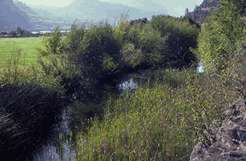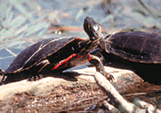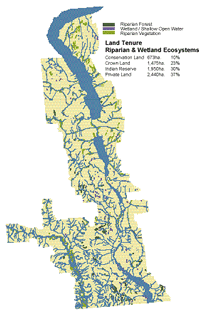|
(published
1998)
Habitat Atlas
for Wildlife at Risk
Riparian & Wetland Ecosystems
 Wetlands
are areas where the land is wet or flooded at some time
of the year, including marshes, bogs and areas of shallow
open water. Riparian areas occur along the banks of
lakes, rivers, and streams. Riparian areas are often
linear, creating a rich habitat along miles of creeks
and rivers that support a diversity of wildlife. Riparian
ecosystems act as filters for overland flows carrying
sediments and pollutants, while wetlands are the storage
basin for floodwaters and nutrients. Riparian forests
consist of black cottonwood, water birch, mountain alder,
and trembling aspen trees. Their root systems reinforce
and protect the banks and shorelines. Vegetation such
as willow, red-osier dogwood and wild rose form tangled
thickets that are ideal habitat for nesting birds. Wetlands
are areas where the land is wet or flooded at some time
of the year, including marshes, bogs and areas of shallow
open water. Riparian areas occur along the banks of
lakes, rivers, and streams. Riparian areas are often
linear, creating a rich habitat along miles of creeks
and rivers that support a diversity of wildlife. Riparian
ecosystems act as filters for overland flows carrying
sediments and pollutants, while wetlands are the storage
basin for floodwaters and nutrients. Riparian forests
consist of black cottonwood, water birch, mountain alder,
and trembling aspen trees. Their root systems reinforce
and protect the banks and shorelines. Vegetation such
as willow, red-osier dogwood and wild rose form tangled
thickets that are ideal habitat for nesting birds.
 Riparian
and wetland ecosystems once covered a significant portion
of the valley bottomlands in the South Okanagan, but
development and flood control measures have reduced
that habitat to less than 4 percent of the land area.
The most significant water project was the channelization
of the Okanagan River between Okanagan and Osoyoos lakes
to control flooding. It is estimated that we have lost
85 percent of valley bottom riparian habitat. The remaining
water-dependent communities are highly fragmented and
in poor health. Riparian
and wetland ecosystems once covered a significant portion
of the valley bottomlands in the South Okanagan, but
development and flood control measures have reduced
that habitat to less than 4 percent of the land area.
The most significant water project was the channelization
of the Okanagan River between Okanagan and Osoyoos lakes
to control flooding. It is estimated that we have lost
85 percent of valley bottom riparian habitat. The remaining
water-dependent communities are highly fragmented and
in poor health.
 In
semi-arid areas like the South Okanagan and Lower Similkameen,
riparian areas are important for maintaining plant and
animal diversity for the whole region. Studies have
shown that 80 percent of wildlife are either directly
dependent on riparian ecosystems or use them more frequently
than other habitats. Extensive, healthy riparian systems
are critical for wildlife, and habitat restoration and
protection are high priorities for wildlife management. In
semi-arid areas like the South Okanagan and Lower Similkameen,
riparian areas are important for maintaining plant and
animal diversity for the whole region. Studies have
shown that 80 percent of wildlife are either directly
dependent on riparian ecosystems or use them more frequently
than other habitats. Extensive, healthy riparian systems
are critical for wildlife, and habitat restoration and
protection are high priorities for wildlife management.
Threats:
- Since wetland and riparian areas cover only 4 percent
of the region yet are critical for so many species,
the loss of a small areas can have a dramatic effect
on local wildlife populations.
- Small ponds and marshes may be permanently drained
and filled for agriculture or development.
- Small lakes are sometimes poisoned and/or restocked
with predatory game fish that eat amphibians and native
fish species.
- Natural travel corridors running between ponds
and surrounding grassland or forest habitats are often
blocked by roads and surrounding development.
- Water consumption for human and agricultural uses
can diminish stream flows, dry up summer breeding
sites, and change mineral concentrations in ponds
and lakes.
- Livestock can trample stream-side vegetation and
reduce the quality of riparian habitat for wildlife.
- Sediments and chemicals from storm water discharge,
agricultural fertilizers and pesticides, and sewage
effluent can erode and impact on riparian and wetland
ecosystems.
Wildlife at Risk for which Riparian and Wetland
habitat is critical:
Red
List
- Tiger Salamander
- Sandhill Crane
- Yellow-breasted Chat
- Western Screech-Owl
- Western Red Bat
|
Blue List
- Great Basin Spadefoot Toad
- Painted Turtle
- American Bittern
- Great Blue Heron
- Bobolink
|

|